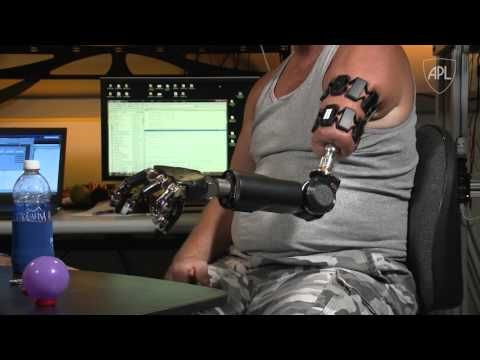Targeted Muscle Reinnervation: Man Controls Prosthetic Arm With His Thoughts

Johnny Matheny has become the first amputee to undergo surgery to reattach the nerves of his arm to an advanced prosthetic device, allowing him to move the robotic arm with his thoughts. Matheny, who lost his left arm to cancer in 2008, has been a proponent of advanced prosthetics for years — and is excited to have the movement and freedom of an arm once again, thanks to researchers at Johns Hopkins University.
Matheny notes that the prosthetic arm can do as much as what a normal hand, arm, and elbow could do. “It’s all natural now,” he said. “Nothing is holding me down. Before, I had limited range; I couldn’t reach over my head and behind my back. Now—boom!—that limitation is gone.”
The surgery, known as targeted muscle reinnervation, is a novel procedure that opens up limitless doors for amputees by allowing the brain to send nerve signals to the prosthetic. Prosthetics can now be controlled by a person’s thoughts, making the movement of daily life — like grabbing objects — much easier. Matheny was also one of the first to undergo a procedure called osseointegration, where doctors attach the prosthetic socket directly onto the limb, inserting a titanium implant into the bone’s marrow. Matheny is the first patient in the U.S. to undergo both target muscle rein nervation and osseointegration.
The notion of controlling technology with our thoughts may seem like science fiction, but it isn’t as far-fetched as you might think. In 2013, researchers developed a prosthetic leg that could be connected to nerves that allowed the patient to control it with their thoughts. Last year, researchers also created a thought-controlled keypad to help people suffering from paralysis or Lou Gehrig’s disease communicate better. And perhaps most remarkably, the Defense Advanced Research Projects Agency (DARPA) has been working on a prosthetic that can provide patients with a sense of touch.
But Matheny is the first to pioneer a prosthetic arm that is both controlled with his thoughts and applied flexibly and comfortably.
Matheny “moves the whole field forward, and not just a small step,” Michael McLoughlin, chief engineer at Johns Hopkins University Applied Physics Laboratory (APL), said in the press release. “The challenge for us next is to really figure out how to get this technology out of the laboratory and into the hands of people that need it.”



























